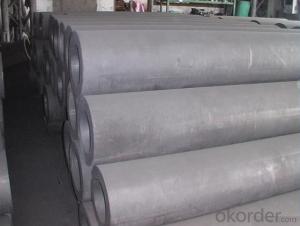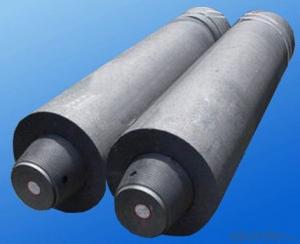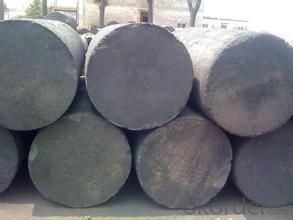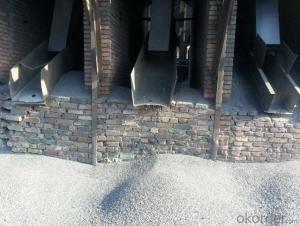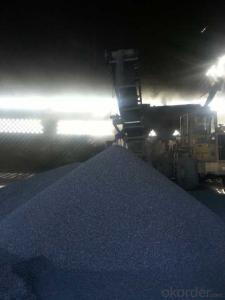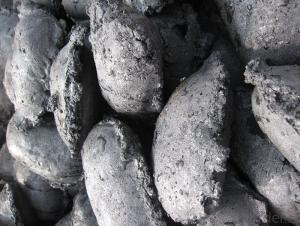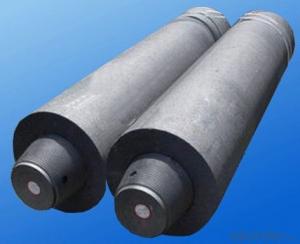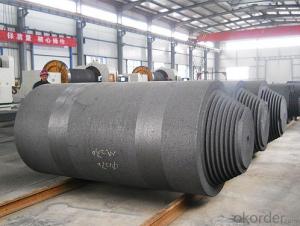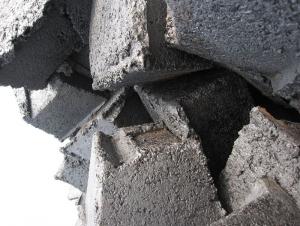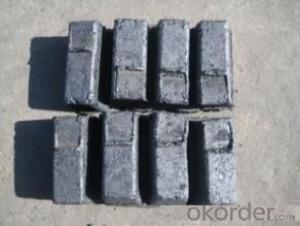Carbon Electrodes With Very Stable Quality
- Loading Port:
- Lianyungang
- Payment Terms:
- TT OR LC
- Min Order Qty:
- 20 m.t.
- Supply Capability:
- 700 m.t./month
OKorder Service Pledge
OKorder Financial Service
You Might Also Like
Carbon Electrodes With Very Stable Quality
Features
1:carbon eletrode
2:for ferroalloy,calcium carbide, silicon metal, manufacture
Graphite/Carbon Electrode Paste Specification
| PARAMETER UNIT GUARANTEE VALUE | ||||||
| Items | Φ500~Φ700 | Φ750~Φ960 | Φ1020~Φ1400 | |||
| Rs μΩ.m | ≤45 | ≤38 | ≤45 | ≤38 | ≤40 | |
| Bulk Desity g/cm3 | ≥1.55 | ≥1.58 | ≥1.55 | ≥1.58 | ≥1.55 | ≥1.58 |
| Bending Strength MPa | 3.5~7.5 | 4.0~7.5 | 3.5~7.5 | 4.0~7.5 | 3.5~7.5 | 4.0~7.5 |
| Compressive Strength MPa | ≥20.0 | ≥20.0 | ≥20.0 | ≥20.0 | ≥19.0 | ≥19.0 |
| Compressive Strength MPa | 3.2~4.8 | 3.0~4.6 | 3.2~4.8 | 3.0~4.6 | 3.2~4.8 | 3.0~4.6 |
| Ash % | ≤2.5 | ≤2.0 | ≤2.5 | ≤2.0 | ≤2.5 | ≤2.0 |
Pictures:
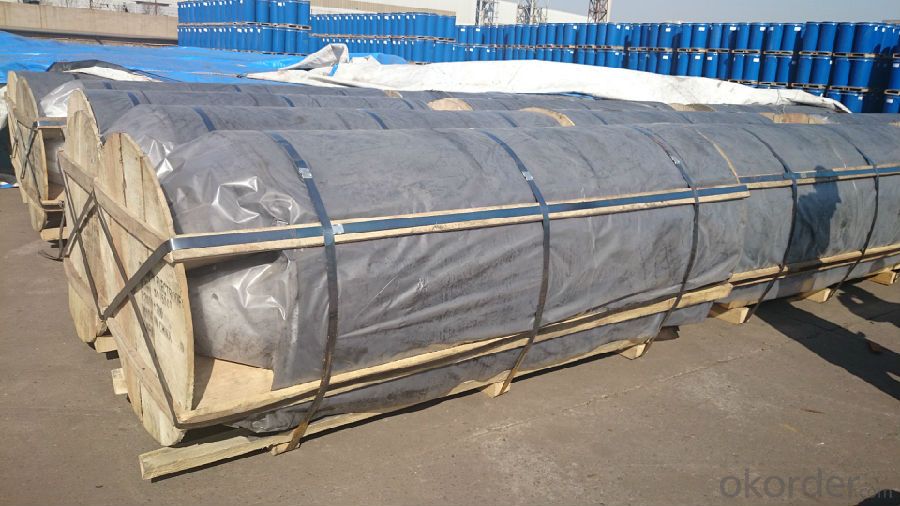
We can adjust the size based on different enquiry. please contact us if you are interested in this materials, we will send our offer as soon as get your kind email.
Do you know the use of the graphite electrode?
1, It is used for the electric arc furnace steel making. (About 70-80% graphite electrode is used for steel making).
2, It is used for the submerged arc furnace, including melting iron alloy, pure silicon, yellow phosphorus,
matte, calcium carbide and so on.
3, It is used for the resistance furnace, such as the graphite making, melting glass, silicon carbide
making and so on.
- Q: How many points can Yongan change for 1 carbon coins?
- Every Thursday at 19:00, carbon points change for carbon coins, 19:30 carbon coins exchange gifts
- Q: How does carbon dioxide affect global warming?
- Global warming is caused by carbon dioxide, one of the main greenhouse gases. When carbon dioxide is released into the atmosphere, it traps heat from the sun and prevents it from escaping into space. This leads to a rise in the Earth's overall temperature, a phenomenon known as the greenhouse effect. The Earth's atmosphere acts like the walls of a greenhouse, trapping heat and warming the planet. Human activities, such as burning fossil fuels, deforestation, and industrial processes, have significantly increased the amount of carbon dioxide in the atmosphere. These activities have released large amounts of carbon dioxide that would have otherwise remained underground for millions of years. As a result, the concentration of carbon dioxide in the atmosphere has reached levels not seen in hundreds of thousands of years. The increase in carbon dioxide levels intensifies the greenhouse effect and worsens global warming. Rising temperatures have negative effects on the Earth's climate system, including the melting of polar ice caps and glaciers, which leads to rising sea levels. This poses a threat to coastal communities and low-lying areas, increasing the risk of flooding and erosion. Additionally, global warming disrupts weather patterns, resulting in more frequent and severe extreme weather events like hurricanes, droughts, and heatwaves. Moreover, global warming impacts ecosystems and biodiversity. Many species are unable to adapt to rapid temperature changes, resulting in habitat loss and an increased risk of extinction. Coral reefs, for instance, are highly sensitive to temperature changes and are experiencing widespread bleaching events due to warmer ocean temperatures. Efforts are being made to reduce greenhouse gas emissions and mitigate the effects of carbon dioxide on global warming. Measures such as transitioning to renewable energy sources, improving energy efficiency, reforesting, and implementing sustainable practices are being taken to curb carbon dioxide emissions and lessen the impacts of global warming.
- Q: How is carbon used in the production of pharmaceuticals?
- Carbon is used in the production of pharmaceuticals through various processes such as carbonization, activation, and purification. It serves as a crucial component in the synthesis of drugs and plays a significant role in drug formulation, purification, and separation processes. Additionally, carbon-based materials are utilized as drug carriers and adsorbents to enhance drug delivery and optimize the efficiency of pharmaceutical manufacturing.
- Q: What should be done to deal with leakage of carbon monoxide from the plant?
- The hazardous and dangerous characteristics of carbon monoxide, carbon monoxide, is the Chinese name of CO. It is the product of incomplete combustion of materials. It is slightly soluble in water and soluble in various organic solvents such as ethanol and benzene. Mainly used in industrial chemical synthesis, such as synthetic methanol, phosgene, etc., or refined metal reducer. Occupation exposure to carbon monoxide in manufacturing steel and iron, coke, ammonia, methanol, graphite electrode, printing and dyeing factory, singeing, internal combustion engine powered coal mining blasting; non occupation contact is more extensive, such as household water heater was boiling water, winter coal, gas heating and so on, will produce carbon monoxide. Carbon monoxide is a flammable toxic gas known, but because of its physical and chemical properties of colorless smelly, so it is not easy to be aware of the harm, so it is not only the occupation killer, or the people's daily living potential. Carbon monoxide mixed with air can form an explosive mixture. When exposed to fire, high heat can cause combustion and explosion. Bottled carbon monoxide in case of high fever, increased pressure within the container, cracking and explosion. Because carbon monoxide has flammable properties, strong oxidizing agents and alkalis are its inhibitions. If the fire, should immediately cut off the gas source; if not immediately cut off the gas source, is not allowed to extinguish the burning gas.
- Q: What are the effects of carbon emissions on the stability of coastal ecosystems?
- Coastal ecosystems are significantly affected by carbon emissions, resulting in various consequences. Ocean acidification, caused by excess carbon dioxide dissolving in seawater and lowering its pH, is one of the primary effects. This acidification harms marine organisms, especially those dependent on calcium carbonate for shell formation, such as corals, oysters, and some plankton. With increased acidity, the ability of these organisms to create and maintain their protective structures is hindered, leading to slower growth, weaker shells, and heightened vulnerability to predation and disease. Furthermore, global warming, which is exacerbated by carbon emissions, leads to rising sea levels and more intense storms. Coastal ecosystems like mangroves, salt marshes, and seagrass beds serve as barriers against storm surges and provide vital habitats for numerous species. However, as sea levels rise, these ecosystems face the risk of submersion, resulting in the loss of their protective functions and the displacement of various plant and animal species. In addition, carbon emissions-driven climate change disrupts ocean currents and disturbs nutrient balances in coastal waters. This disturbance can cause shifts in the distribution and abundance of marine species, affecting the entire food chain. For example, if certain species that serve as prey or predators are negatively impacted, it can create a ripple effect throughout the ecosystem. These disruptions ultimately lead to reduced biodiversity, the loss of crucial species, and the potential collapse of entire coastal ecosystems. To safeguard these fragile ecosystems and the countless species that depend on them, it is imperative to reduce carbon emissions and mitigate the impacts of climate change.
- Q: What are the properties of carbon-based ceramics?
- Carbon ceramics, also called carbon-based ceramics, are a distinct group of materials known for their exceptional properties, making them highly sought-after for various uses. These properties consist of: 1. Exceptional resistance to high temperatures: Carbon ceramics demonstrate remarkable thermal stability, enabling them to endure extremely high temperatures without significant deterioration or structural changes. This characteristic renders them ideal for applications in high-temperature environments like aerospace components, brake systems, and heat shields. 2. Low density: Carbon ceramics are characterized by their lightweight nature due to their low density. This quality proves advantageous in industries where weight reduction is essential, such as automotive and aerospace, as it enhances fuel efficiency and overall performance. 3. High hardness and resistance to wear: Carbon-based ceramics possess outstanding hardness and wear resistance, endowing them with durability and the ability to withstand abrasive forces. This attribute makes them suitable for use in cutting tools, bearings, and other applications that require resistance to wear and erosion. 4. Excellent resistance to chemicals: Carbon ceramics are renowned for their excellent chemical resistance, enabling them to withstand corrosion and degradation when exposed to aggressive chemical environments. This property proves valuable in industries like chemical processing, semiconductor manufacturing, and others that require resistance to chemical attack. 5. Good electrical conductivity: Unlike traditional ceramics, carbon-based ceramics exhibit good electrical conductivity due to the presence of carbon in their composition. This quality makes them useful in applications that necessitate both thermal insulation and electrical conductivity, such as heating elements, electrodes, and electronic components. 6. Customizable properties: Carbon ceramics offer the advantage of tailoring their properties to meet specific requirements by adjusting the composition and processing methods. Variables like carbon content, porosity, and microstructure can be modified to customize the mechanical, thermal, and electrical properties of carbon ceramics to suit particular application needs. In conclusion, carbon-based ceramics possess a unique set of properties, including high temperature resistance, low density, high hardness, excellent chemical resistance, good electrical conductivity, and the ability to customize their properties. These properties make them valuable materials across a wide range of industries, including aerospace, automotive, chemical processing, and electronics.
- Q: How does deforestation contribute to carbon emissions?
- The role of deforestation in contributing to carbon emissions is significant. When forests are cleared or burned, the carbon stored in trees and vegetation is released into the atmosphere as carbon dioxide (CO2), a greenhouse gas that contributes to global warming. Forests act as natural carbon sinks, absorbing CO2 from the atmosphere through photosynthesis. Trees and plants convert CO2 into oxygen and store the carbon in their trunks, branches, leaves, and roots. This process helps regulate the Earth's climate by reducing the concentration of CO2 in the atmosphere. However, deforestation disrupts this natural carbon storage system. The carbon once stored in trees and vegetation is released back into the atmosphere, increasing the concentration of CO2. Burning forests exacerbates this process, releasing even larger amounts of carbon through the combustion of trees and plant material. The loss of forests also leads to a decrease in biodiversity and the destruction of habitats for numerous species, which disrupts the delicate balance of ecosystems. As a result, these ecosystems become less efficient at absorbing and storing carbon, further contributing to increased carbon emissions. Moreover, deforestation indirectly contributes to carbon emissions through various means. For example, when trees are cleared, the exposed soil is exposed to sunlight and heat, causing it to dry and release stored carbon. Additionally, deforestation often leads to the conversion of land for agricultural purposes, such as livestock farming or palm oil plantations, which can increase methane emissions, another potent greenhouse gas. To summarize, deforestation contributes to carbon emissions by releasing stored carbon, disrupting the natural carbon storage system, and indirectly contributing to the release of other greenhouse gases. It is crucial to address deforestation and promote sustainable land management practices to mitigate the effects of climate change and reduce carbon emissions.
- Q: Which carbon content is larger, steel or pig iron?
- The carbon content of pig iron is large. The carbon content of pig iron is usually 2.5%--4%, and the carbon content of steel is 0.05% - 2%
- Q: What are the main sources of carbon emissions?
- The main sources of carbon emissions include burning fossil fuels such as coal, oil, and natural gas for electricity, transportation, and industrial processes. Deforestation and land-use changes also contribute to carbon emissions by releasing stored carbon into the atmosphere.
- Q: What does carbon cloth tonnage mean?
- Carbon cloth tonnage is illegal: mean a square centimeter of sectional area of carbon cloth tension of tonnage. Meaning that the carbon cloth rolled into a solid "rod" if the cross-sectional area of the bar is 1 cm, the maximum tension tonnage it bear -- carbon cloth tonnage.
Send your message to us
Carbon Electrodes With Very Stable Quality
- Loading Port:
- Lianyungang
- Payment Terms:
- TT OR LC
- Min Order Qty:
- 20 m.t.
- Supply Capability:
- 700 m.t./month
OKorder Service Pledge
OKorder Financial Service
Similar products
Hot products
Hot Searches
Related keywords
